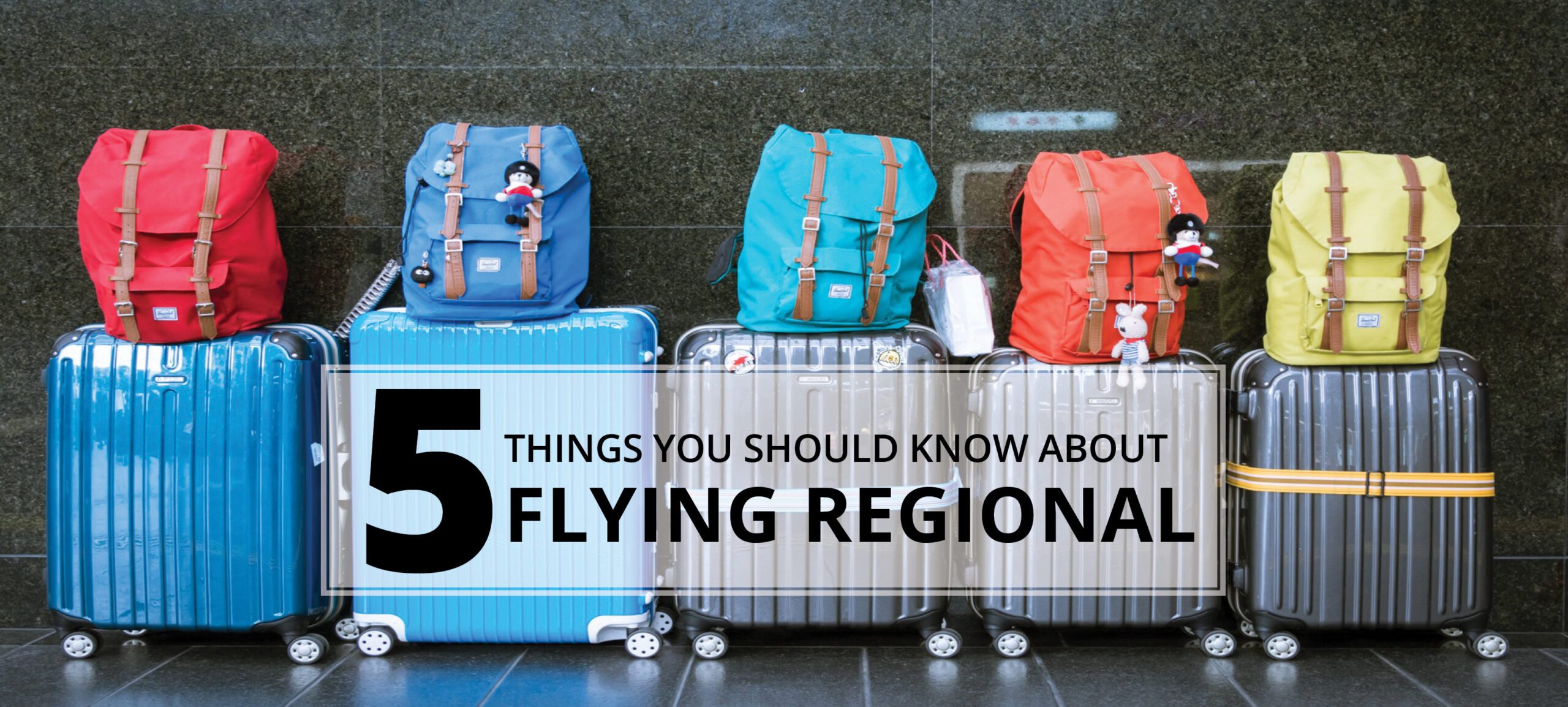

When booking a flight, many people don’t realize that they have booked themselves on a regional (or express) carrier. It can come as a big surprise when they reach the gate and see the (much) smaller-than-expected aircraft.
Here are five things you should know about flying regional.
(1) How do I know if I am flying on a flight operated by a regional carrier?
Avoid surprises by knowing what kind of plane you’re taking. Knowing that you are flying on a regional jet is as easy as taking a second look at your boarding pass. A regional flight is marked using the wording “operated by…” or “doing business as.”
For example: On a United Airlines flight from Newark, NJ to Albany, NY, the boarding pass may be marked “Operated by CommutAir d/b/a United Express.” This indicates that your flight is operated by one of United’s express carriers, also known as a regional airline.
An advanced, more nuanced clue to being on a regional flight can be found by the gate structure of your departure airport. For example, the “F” gates located at Chicago’s O’Hare International Airport are specified for arrivals and departures of regional aircraft. If you’re at Gate F, you’ll probably be flying on one of the smaller planes. Not an airport aficionado? Just stick with checking the boarding pass.
(2) Why are they taking my carry-on luggage? After all, it is my CARRY-ON.
There’s nothing more frustrating than being separated from your luggage, even though you spent hours watching packing videos on YouTube, invested in compression cubes, and struggled to make your belongings fit inside the airline’s specified dimensions.
Taking your carry-on luggage before you board the plane is known as gate-checking luggage, and there’s a good reason for it.
Regional carriers fly much smaller planes than the mainline aircraft. The capacity of the carry-on bins is reduced by half, or even a quarter, of the size of the Boeing 737 you were probably expecting to ride. This means those 9-inch x 14-inch x 22-inch (United’s luggage size specification) carry-on bags no longer fit in the overhead compartments, and have to be stored under the plane.
Although it may initially seem like a nuisance (especially if you weren’t expecting it) this process is very similar to valet service for your car – but better because it’s free!
The bag is dropped at the end of the jet bridge, a tag is received, and then you get it back when you arrive. Simple as that, alleviating the time it takes to struggle with the overhead compartments – and the stress of trying to do it yourself without wounding your neighbor in the process. It’s actually a complimentary perk, not a burden.
(3) When should I get to the airport? I don’t need to show up at the airport two hours early, right?
Boarding time is not the same as departure time! In fact, boarding is roughly a half hour prior to departure. The plane is not going to wait for you so it’s absolutely better to arrive early.
Regional airlines are known to have short turnaround times, averaging under 30 minutes. This time starts when they pull into their gate, and ends when they release the brake to depart. The process of deplaning and aircraft and boarding it with the next set of passengers is done with the highest amount of efficiency. (In fact, some airlines have time quotas that the crews must meet.)
Bottom line: Don’t assume you’ll breeze through security and arrive at your gate just as the door is closing. Follow the two-hour minimum to ensure you board on time. And remember, it is even more critical when you’re traveling on a regional aircraft.
(4) Isn’t the seating on a smaller plane much less comfortable?
There’s good news and bad news when it comes to seating on a regional aircraft.
Let’s get the bad news out of the way first. Yes, the plane is smaller, so in some cases, the seats may lose an inch or two in width. This can be noticeable when you finally find your seat on what seems to be the endless journey to your destination. But remember, regional flights are the shorter routes to (or from) the mainline hubs (with the larger planes for the longer stretch of your trip). CommutAir, for example, averages around a 45-minute flight time because the route map is highly concentrated along the east coast.
Now for the good news – seat configuration!
The regional airplanes — that move nearly 150 million passengers annually — do not have the dreaded middle seat. You read that correctly. NO. MIDDLE. SEAT. This is because the layout of the seats is generally one seat on the left of the aisle and two on the right, or sometimes two on each side of the aisle.
Let’s do the math. On your average Embraer 145 regional jet, you have a 66% chance of getting an aisle seat, a 66% chance of getting a window seat, and a 33% chance of getting both at the same time.
It’s all about perspective: a smaller seat isn’t so terrible if you never have to sit in the middle!
(5) When is the best time to fly? What about connecting flights?
Improving your day-of travel experience can be as simple as changing your departure time. Around the peak travel days, look to book flights that depart earlier in the day. The dreaded 6am flights aren’t just for business travelers. The first flights of the day are usually on time, with delays coming later due to weather, staffing, and potentially mechanical issues. An early flight allows you room for adjustment should delays arise – while still getting you to your destination at a decent time.
It is also essential to be prepared for a connecting flight. If you’re flying regional, it’s likely that you have a connection and need to allow enough time to get to the next aircraft while respecting those quick turn around times. Booking an early morning flight usually means you have several alternate connections should you encounter a delay, or miss your flight.
Overall, just understanding how flying regional is different can create a less stressful, more fluid travel experience. Check your boarding pass so you’re not surprised, and remember, perspective matters when flying small. Valet service for your bag, less time in the air, no middle seat….flying regional isn’t so bad after all!
# # #
SR, Pilot Recruiter & Communications Assistant







